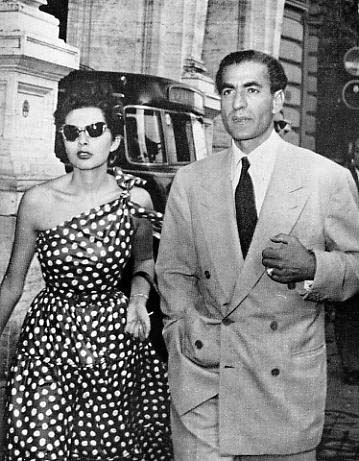 |
| Soraya and the Shah traveling in London, 1958 (AFP/Getty Images) |
Rome, Aug. 18 — Iran’s refugee Shah Mohammed Reza Pahlavi [1] said today he did not plan to abdicate his throne but was vague about any attempt to return to riotous Tehran [2]. Indications were that any return would be in the distant future [3].
 |
| Queen Soraya of Iran, ca. 1950s (Wikimedia Commons) |
His pilot disclosed that in their hasty dash out of Iran Sunday, the Shah and his 20-year-old green-eyed Queen, Soraya [4], managed to grab up and bring along her personal royal jewels. These presumably did not include any of the priceless crown jewels — among them the famous mirror of light (or sea of light) diamond [5] — which are kept locked in a huge vault of the National Bank of Iran as state property [6].
The pilot, Mohammed Khatami [7], indicated in an interview that the Shah wanted to sell his private plane. It was left behind in Baghdad, Iraq, when the small royal party came on to Rome today in a British airliner.
 |
| The Shah and Soraya in Rome, 17 August 1953 (Wikimedia Commons) |
The suddenness of their flight out of Iran and the Shah’s anxiety over whether they could make it ahead of Premier Mosaddegh’s forces were described by the pilot. “We left on such short notice I didn’t have time even to bring along a spare shirt or call my wife by telephone to tell her I was leaving,” Khatami said. “But I’m not the only one short on shirts. The Shah is, too. He tried to go shopping this afternoon when we got into Rome. Photographers were after him everywhere he stopped and he had to put it off.”
 |
| A portrait of Soraya taken in Paris, December 1951 (ARCHIVE/AFP/Getty Images) |
The pilot denied reports that Iranian aircraft tried to escort them or interfere with them in the flight to Baghdad Sunday from the Shah’s vacation palace at Ramsar on the Caspian Sea shore.
Khatami said the Shah and Queen Soraya were accompanied out of Iran only by himself and Aboulfath Atabay, personal attache to the Shah, who bears the title “chief hunter of the imperial court.”
NOTES
1. Mohammad Reza Pahlavi (1919-1980) was the the last Shah of Iran, reigning from 1941, when his father was deposed, until the Iranian Revolution in 1979. Pahlavi’s reign was, to put it mildly, tumultuous and controversial. He died of cancer in exile in Egypt in July 1980.
2. Following Prime Minister Mohammad Mosaddegh’s nationalization of Iran’s oil industry, the United Kingdom and the United States jointly formed a plan to oust him and regain control of the area’s oil. The Shah was initially reluctant to go along with the planned coup d’etat, known as Operation Ajax, but the CIA pressured his twin sister, Princess Ashraf, to convince him — and provided him with a substantial cash bribe. In August 1953, he agreed to the plan, but the first attempted coup on August 15 failed. In response, the Shah fled the country with Queen Soraya, traveling first to Baghdad and then to Rome. Mosaddegh’s government was ultimately overthrown on August 19, and General Fazlollah Zahedi was installed as his successor. As many as 300 Iranians lost their lives in the coup, more were arrested and punished in the aftermath, and Mosaddegh was tried and convicted of treason. He died under house arrest in 1967. (A timeline of the coup is available here.)
3. The future wasn’t so distant. The Shah returned to Iran on August 21, 1953, stopping on the way to pick up his private plane in Baghdad. The director of the CIA, Allen Dulles, flew with him, but Queen Soraya remained behind in Rome with Princess Ashraf, the Shah’s twin sister. Though the New York Times reported that the Shah traveled “with a heart full of joy for a bright future,” the coup was really the beginning of the end of his reign, stoking significant distrust of his major foreign supporter, the United States, among Iranians and others in the Middle East. The Shah was thought by many to be the puppet of a Western government, and resistance to his attempts to enact Western-style reforms led to the Iranian Revolution in 1979.
4. Soraya Esfandiary-Bakhtiary (1932-2001) was the second wife of Mohammad Reza Pahlavi. She was Iran’s queen consort during their marriage, which lasted from 1951 until 1958. (You can read more about her wedding jewels here.) They divorced after Soraya was unable to provide him with an heir. She later embarked on a brief film career.
5. The Daria-i-Noor Diamond, whose name means “sea of light” in Persian, is a pale pink gem that forms part of the Iranian crown jewel collection. Mined in India, the stone is one of the largest cut diamonds in the world, measuring 182 carats.
6. The Iranian crown jewels still reside in the Central Bank of Iran in Tehran today.
7. Mohammad Amir Khatami (1920-1975) was the Shah’s personal pilot. Four years after the coup, he was appointed commander of the country’s air force. In 1959, he became the Shah’s brother-in-law, marrying Princess Fatimeh Pahlavi, the Shah’s half-sister. He had previously been married to one of his cousins, who had died in 1954.
Leave a Reply
You must be logged in to post a comment.